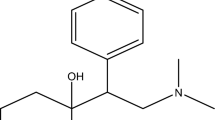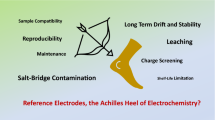Abstract
It is conceivable that sophisticated sensing and other electrochemical devices can be formed by interfacing more than one solid electrolyte in an electrochemical chain involving more complicated sequences of electrodes, interfaces, in-situ catalysts and semi-permeable membranes. As sensor systems become more elaborate, the need for optimising several interfaces and reaction equilibria becomes critical.
In the example of YSZ/Nasicon based sensors, the emf response can be adequately explained by the interfacial reactions. In the use of doped perovskite interfaced with an oxygen or a chloride ion conductor, although useful sensors can be devised with Nernstian type of response, the interfacial phenomena or the electrode reactions are more complicated and can not be explained by simple interfacial reactions. A brief review of the relevant concepts is presented.
Similar content being viewed by others
10. References
N. Imanaka, G. Adachi, and J. Shiokawa, Chem. Lett., (1983) p. 287.
M. Gauthier, and A. Chamberland, J. Electrochem. Soc.124, 1579 (1977).
W.L. Worrell, in: Proc. Int Meeting on Chemical Sensors (1983) p. 332.
R.V. Kumar and D.J. Fray, Solid State Ionics28–30, 1688 (1988).
W. Weppner, Sensors and Actuators12, 107 (1987).
J. Liu and W. Weppner, Solid State Commun.76, 311 (1990).
R. Akila and K.T. Jacob, J. Appl. Electrochem.18, 245 (1988).
M. Itoh and Z. Kozuko, Trans. of the Jpn. Inst. of Metals26, 17 (1985).
K.T. Jacob, D.B. Rao and H.G. Nelson, J. Electrochem. Soc.125, 758 (1978).
D.J. Fray, R.V Kumar and G.M. Kale, British Patent Application, 9521169.4 (1995).
R.V. Kumar, J. of Alloy and Compounds250, 501 (1997).
R.V. Kumar and D.J. Fray, in: Proc. Sensors and Modelling, TMS, Orlando (1997) p. 317.
D.J. Slater, R.V. Kumar and D.J. Fray, in: Proc, Solid State Ionics 95, Singapore (1996) p. 1063.
R.V. Kumar, L.J. Cobb and D.J. Fray, Ionics2, 162 (1996).
L.J. Cobb, R.V. Kumar and D.J. Fray, Ionics2, 231 (1996).
M Hassan, M. Swetnam, R.V. Kumar, D.J. Fray and A.G. Clarke, in preparation.
N.N. Ahmad, G.M. Kale, R.V. Kumar and D.J. Fray, in: Proc. of the 10th Int. Conf. on Solid State Ionics, Singapore (1996) p. 1013.
Author information
Authors and Affiliations
Rights and permissions
About this article
Cite this article
Kumar, R.V. Devices based on interfacing two or more solid electrolytes. Ionics 5, 194–199 (1999). https://doi.org/10.1007/BF02375839
Received:
Accepted:
Issue Date:
DOI: https://doi.org/10.1007/BF02375839




